San Francisco Landmarks Swedish American Hall
The Swedish Society of San Francisco and many Scandinavian organizations gathered with officials and neighbors at the Swedish American Hall in San Francisco on May 2, 2015 to celebrate the official recognition of the Swedish American Hall, its design by Swede and master architect August Nordin, and its fine Swedish craftsmanship of more than a century ago.
-
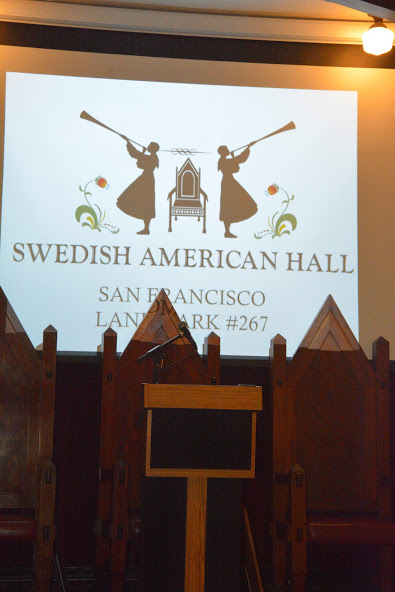 Swedish American Hall: San Francisco Landmark #267. © Swedish Society of San Francisco; Swedish American Hall
Swedish American Hall: San Francisco Landmark #267. © Swedish Society of San Francisco; Swedish American Hall -
-
Distinguished Swedish Society members Fred and Susan Bianucci greeted guests at the door of the Swedish American Hall: He was in his American suit; she in a Swedish provincial costume. Inside, guests could ascend the grand staircase or ride the new elevator, which goes from the well-known basement nightspot Café du Nord to the private top floor with its Archives room, “Svea” and board room, “Verdandi.” Verdandi was one of the three Nordic norns — the weird sisters who wove each one’s fate: yesterday, today and tomorrow. Verdandi was responsible for the future. The Society’s Swedes who built the hall evidently felt the community’s future would be fashioned in this room.
This was the first time in two years that many visitors had been in the building since its long renovation. Now the hall is under the new management of the Swedish Society’s master tenant, the Upper Market Vikings (Dylan McNiven, an established restauranteur who has several dining venues and Enrique Landa, entrepreneur and managing partner). Their affiliation with some remarkable San Francisco dining, bar and entertainment masters assures the building will remain a destination in the heart of one of the city’s most dynamic districts.
The redesigned Café du Nord, with its classic wooden back bar kept intact, remains one of the city’s oldest saloons. It now has a lounge with a small stage for added entertainment. This will be operated by Chef Thomas McNaughton.
The multistoried building now boasts four kitchens, actually. And since the Upper Market Vikings (UMV) has a liquor license to accompany its dance hall permit, it can now host parties and banquets on all levels for all occasions and any number of guests. -
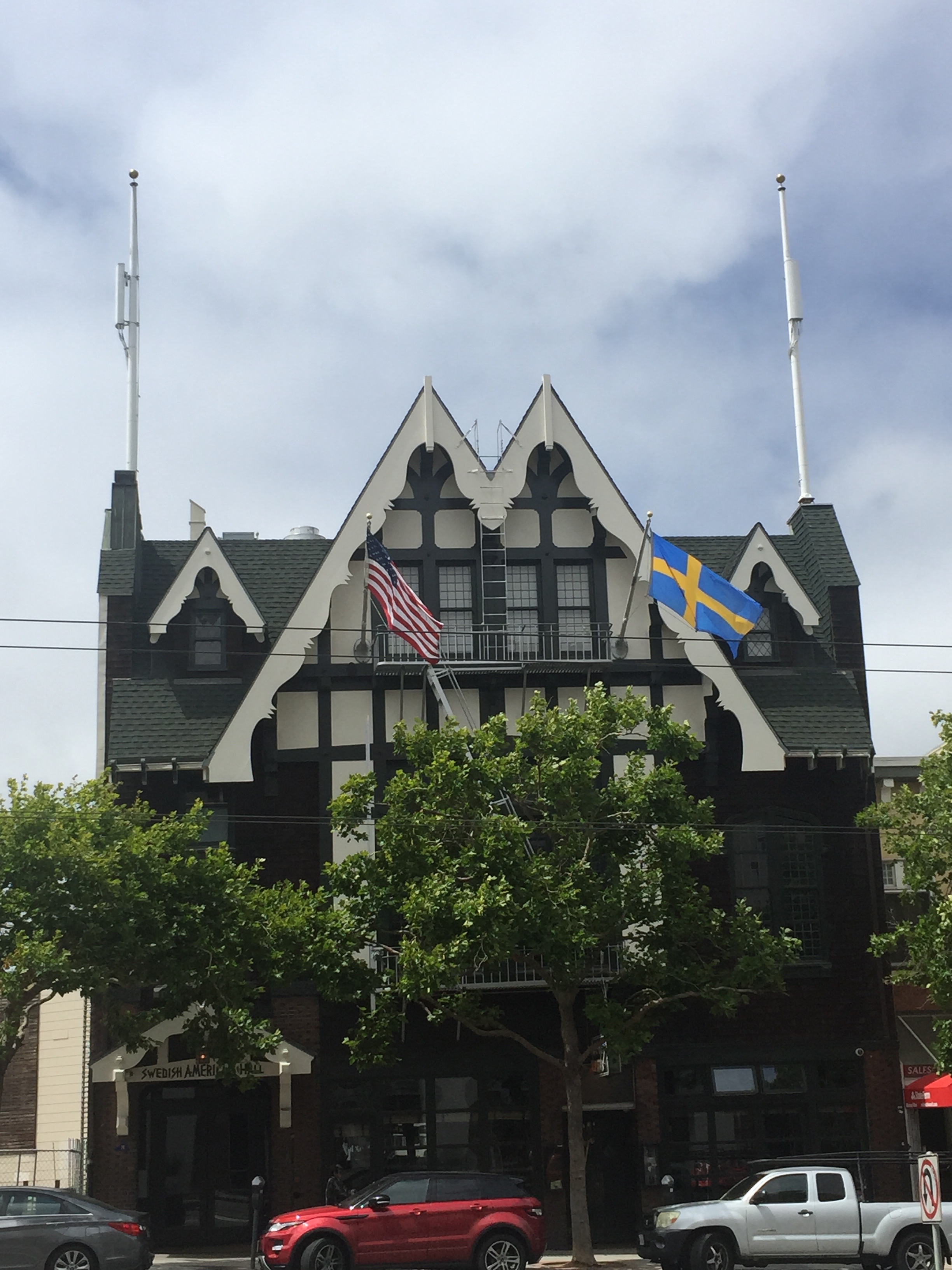 August Nordin’s masterpiece: the Swedish American Hall of 1907, today (in bloom). © Ted Olsson
August Nordin’s masterpiece: the Swedish American Hall of 1907, today (in bloom). © Ted Olsson -
-
At the celebration, Ted Olsson, secretary of the Society, introduced himself as Master of Ceremonies for the occasion. This role was a distinct honor for him, for immediately before and after the 1906 earthquake, his paternal grandfather had been secretary and a member of the hall’s building committee. Olsson’s maternal grandfather managed the hall for 30 years after it was built.
As it had once been, so will it become again, bursting with activity as the daily hub of the new Scandinavian center of the city, then surrounded with Scandinavian homes and businesses concentrated in this unscathed portion, while the rest of the city rebuilt itself.
Before the earthquake the Swedes and Scandinavians were scattered about the city. Nevertheless, the Swedes had established Scandia Hall across the street from the new City Hall being built. Even then, before the disaster, they were dreaming of a more imposing center and had formed a committee for that purpose. So, even before the calamity and long before the hall itself, there was a Swedish American Hall Building Committee —and after the quake they were already mobilized to rebuild.
The Swedish Society of San Francisco, the oldest and largest individual Swedish organization of the region, was a benevolent society with 400 or more men as members. Shortly after the quake they located a perfect location for their new hall on upper Market Street. Thanks to the generosity of Erik O. Lindblom — “the Lucky Swede” who struck it rich in the Yukon and became executive of the Swedish American Bank — who offered them a considerable loan, made it possible for them to purchase the property. They were also fortunate in choosing Swedish-born August Nordin, one of their members and already a noted San Francisco architect, to design an appropriately distinctive hall for them. By the end of the following year Nordin’s inspired plans had been realized by contractor Andrew Olson and his Swedish craftsmen. -
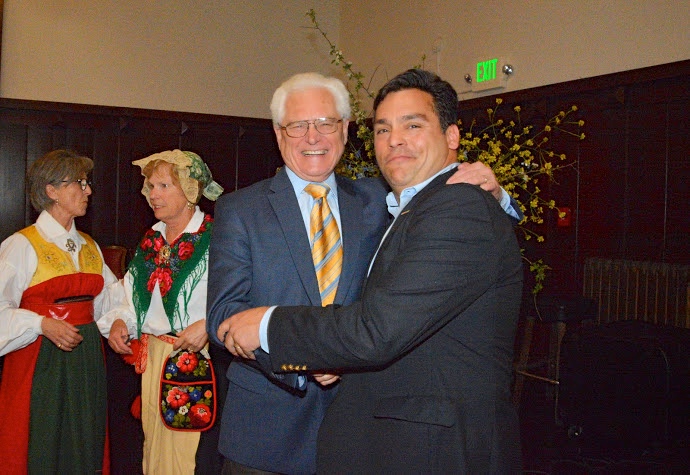 Olsson and Landa, for the Society & UMV, celebrate fulfillment today and prosperity tomorrow. Photo by Jake Tomlinson. © Swedish Society of San Francisco, 2015
Olsson and Landa, for the Society & UMV, celebrate fulfillment today and prosperity tomorrow. Photo by Jake Tomlinson. © Swedish Society of San Francisco, 2015 -
A landmark event
Given its history, it was appropriate that the ceremony on May 2 began with the dual American and Swedish national anthems, since that duality was very important to these early immigrants’ identity. Zaida Binetti led the audience in the anthems and as they sang in unison; the Zaida Singers stood in the balcony and provided harmony, so important to Swedes’ choral tradition.
Society President Bengt Sandberg welcomed all to this combined ceremony, celebrating the building’s new landmark status (number 267 in the city of San Francisco) and also congratulating the Society’s entrepreneurial partners in the renovation, MacNiven and Landa. Sandberg noted this partnership has two goals: to make our partners commercially successful and to continue the mission of the Society to promote and perpetuate our Swedish and Scandinavian communities’ history and culture.
He introduced the current board, emeritus board members, and the women of the Swedish American Hall’s Library and Archives Committee (Susan Bianucci, Astrid Olsson, Muriel Beroza, Linda Zalko and the late Ulla Sabelstrom). He concluded by reading the congratulatory letter, both warm and heartfelt, from Consul General Barbro Osher, whose duties required her to be absent on this most auspicious day.
The stage at the front of this grand ballroom had three Nordic thrones across the back, fixtures for fraternal rites since the hall’s beginning. With President Sandberg seated in the center, flanking him were California State Assembly member David Chiu and on his other side our city Supervisor Scott Wiener, who carried the landmark legislation to fruition. As people entered the hall they had seen congratulatory messages from several officials projected on the screen at the back of the stage: from U.S. Senator Feinstein, U.S. Congress Minority Leader Nancy Pelosi, California Senator Mark Leno and San Francisco Mayor Edwin Lee.
Olsson called to the podium Assemblyman Chiu, who spoke of the importance of the city’s diversity and of people retaining their ethnic traditions even as they adopted American customs. He presented to President Sandberg a beautiful, framed Assembly Resolution, citing the history of the San Franciscan Swedes which led to the building of the hall, and more than a century later to this day celebrating it as an official landmark.
District Supervisor Scott Wiener was introduced and thanked for garnering the official vote resulting in the landmark. He mentioned he always had imagined the hall was already landmarked, noting that he was very familiar with the hall, having attended many events here. He thanked the Swedish Society for preserving this building so well and for agreeing to have it landmarked in perpetuity, for it is now a legacy for all San Franciscans. With that, he, too presented President Sandberg with both his own resolution, endorsed by the full Board of Supervisors, and with the proclamation of the mayor who named the date as Swedish American Hall Day. -
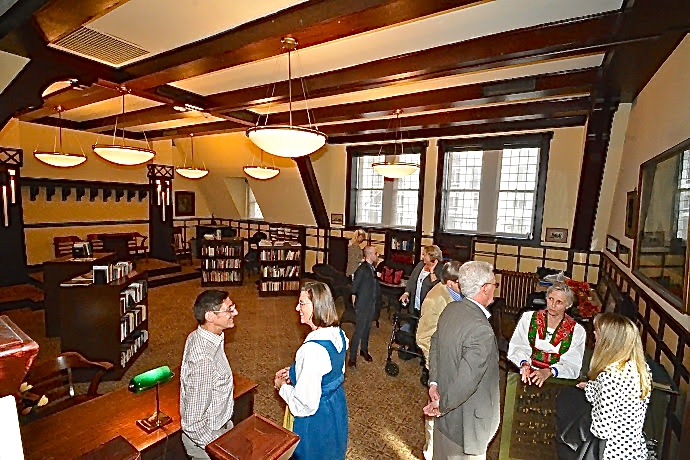 Our Archivists show visitors their room of treasures. Photo by Jake Tomlinson. © Swedish Society of San Francisco, 2015
Our Archivists show visitors their room of treasures. Photo by Jake Tomlinson. © Swedish Society of San Francisco, 2015 -
Celebrating Swedish style
The MC explained how cherished choral singing is to the Swedes, and it was time for one of the highlights of the ceremony: visiting from Sweden, the University Chamber Chorus of Piteå under the direction of its famed conductor Erik Westberg. On their concert tour in San Francisco, they had performed at Mission Dolores Basilica and the Swedish Church in America at the Norwegian Seamen’s Church. Westberg stood in the center aisle about three quarters of the way toward the back. With a flick of his wrist, the chorus rose from their seats, scattered in front of the audience, and sang, “Trilo” (1997), adapted by Ale Möller, a song from the west coast of Sweden about sailors afloat and family ashore greeting each other as they neared home while the wind and waves blew currents between them. While singing, choir members stepped as a unified chorus onto the stage. They next sang Summer Hymn (en vänlig grönska) by Waldemar Åhlen. But it was the concluding piece, Stenhammar’s Värnatt, Op.30, No.2 (1912), which really blew the ceiling off the hall. Their power and presence were simply awesome and inspirational. They received sustained applause and felt the heartfelt appreciation.
Returning to the microphone, the MC took the opportunity to thank all of the men and women in native folk costumes who graced the occasion. He asked all those who were Swedish or Scandinavian by heritage or affiliation to stand as he read the names of the various societies, lodges and clubs that are active today. The standees were all warmly applauded for sustaining our community — which brought us to this celebration.
Officials and other dignitaries were recognized: Olsson thanked Dennis Richards, a friend and colleague from the neighborhood and from their service on a city-appointed committee, now Planning Commissioner Richards, for having encouraged us to landmark the Hall. Later MacNiven in his comments noted to Richards that the Society and UMV had delivered on its commitment. Olsson mentioned a number of others who were important in bringing us to this occasion, especially Historic Preservation Commissioner Diane Matsuda, the local Planning Department, especially Director John Rahaim, Tim Frye and Moses Corrette, and he particularly recommended to City Archivist Susan Goldstein that she get a copy of Jonathan Lammers’ superb landmark study.
Olsson also thanked longtime neighbor, Stan Wong and his family — whose adjoining property is being developed by Greystar into a six-story, 88-unit apartment complex — as well as the neighborhood associations who have all supported us. He took special time to recognize UMV’s partners: Chef Ryan Pollnow of Aatxe restaurant, Chef Thomas McNaughton of Café Du Nord Restaurant, which will open by the end of this month, and the Bon Vivants, who were then in Chicago as nominees for the James Beard Award.
But the final, touching surprise came when the MC introduced Dylan MacNiven, speaking for UMV. MacNiven thanked the Society for entrusting them with care for this treasured hall and particularly thanked Fred Bianucci, head of the Society’s building committee, for holding UMV to the meticulous detail assuring the hall’s longevity and safety throughout the years. MacNiven also thanked everyone for their patience and support as UMV helped the Society restore the hall and put in the elevator originally planned for the 1907 building. But it was the very special gift that he and Landa presented to President Sandberg that was so appropriate: For this centennial year of San Francisco’s 1915 world’s fair, they had searched and found in London an original medal stamped for Swedes participating in that world’s fair. He presented this to President Sandberg as a token of their esteem for the treasure that they too now curate. -
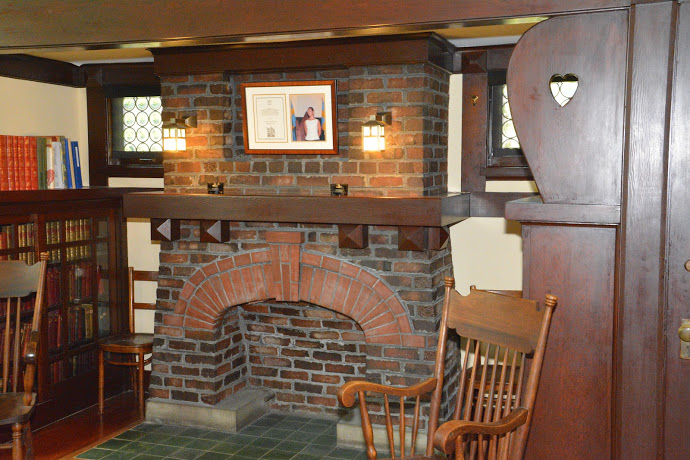 The inglenook in the board room (Verdandi) of the Society. Photo by Jake Tomlinson. © Swedish Society of San Francisco, 2015
The inglenook in the board room (Verdandi) of the Society. Photo by Jake Tomlinson. © Swedish Society of San Francisco, 2015 -
Now that the hall is landmarked as August Nordin’s masterpiece, the Swedish Society with UMV are proud to continue to serve the community, neighborhood and city for another century as a most distinctive historical site with ultra-modern facilities.
-
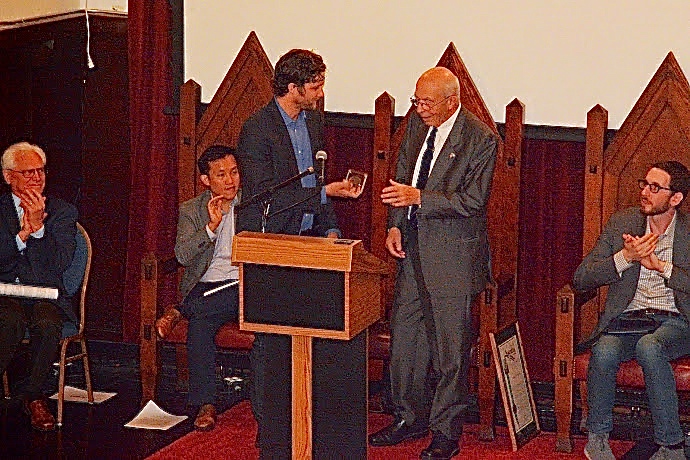 Dylan presents Bengt Sandberg with the PPIE 1915 Swedish medallion. Photo by Jake Tomlinson. © Swedish Society of San Francisco, 2015
Dylan presents Bengt Sandberg with the PPIE 1915 Swedish medallion. Photo by Jake Tomlinson. © Swedish Society of San Francisco, 2015 -
~TED OLSSON,
San Francisco -
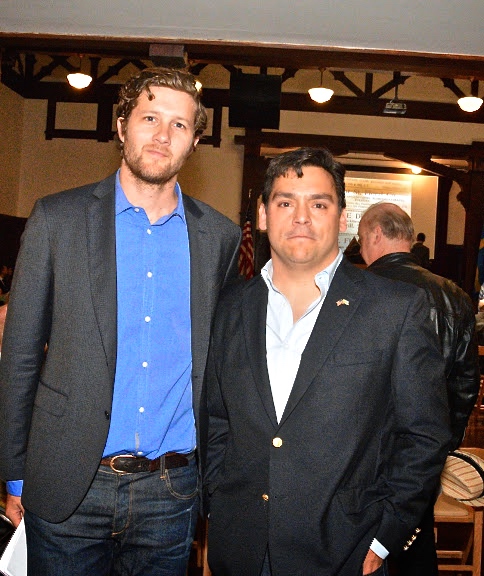 Dylan MacNiven and Enrique Landa, the Upper Market Vikings. Photo by Jake Tomlinson. © Swedish Society of San Francisco, 2015
Dylan MacNiven and Enrique Landa, the Upper Market Vikings. Photo by Jake Tomlinson. © Swedish Society of San Francisco, 2015 -
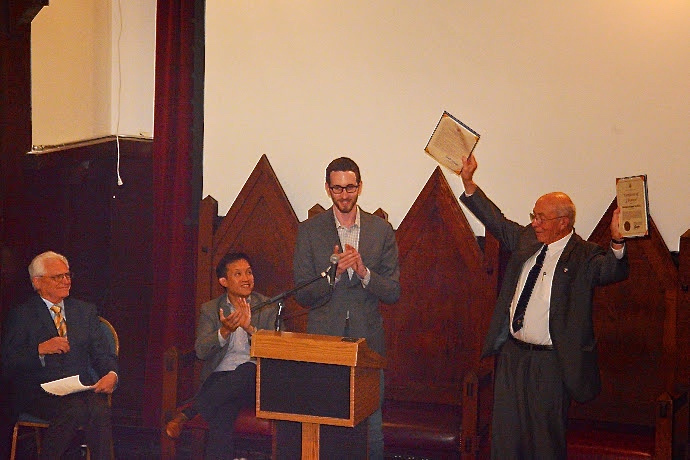 Swedish Society of San Francisco President Bengt Sandberg displays Sup. Wiener’s Resolution and Mayor Lee’s Proclamation. Photo by Jake Tomlinson. © Swedish Society of San Francisco, 2015
Swedish Society of San Francisco President Bengt Sandberg displays Sup. Wiener’s Resolution and Mayor Lee’s Proclamation. Photo by Jake Tomlinson. © Swedish Society of San Francisco, 2015 -
-
-
